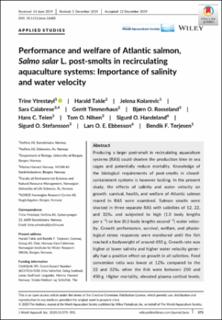Performance and welfare of Atlantic salmon, Salmo salar L. post-smolts in recirculating aquaculture systems: Importance of salinity and water velocity
| dc.contributor.author | Ytrestøyl, Trine | |
| dc.contributor.author | Takle, Harald Rune | |
| dc.contributor.author | Kolarevic, Jelena | |
| dc.contributor.author | Calabrese, Sara | |
| dc.contributor.author | Timmerhaus, Gerrit | |
| dc.contributor.author | Rosseland, Bjørn Olav | |
| dc.contributor.author | Teien, Hans-Christian | |
| dc.contributor.author | Nilsen, Tom Ole | |
| dc.contributor.author | Handeland, Sigurd O | |
| dc.contributor.author | Stefansson, Sigurd | |
| dc.contributor.author | Ebbesson, Lars | |
| dc.contributor.author | Terjesen, Bendik Fyhn | |
| dc.date.accessioned | 2020-11-06T10:23:45Z | |
| dc.date.available | 2020-11-06T10:23:45Z | |
| dc.date.created | 2020-07-21T13:55:47Z | |
| dc.date.issued | 2020 | |
| dc.identifier.citation | Journal of the World Aquaculture Society. 2020, 51 (2), 373-392. | en_US |
| dc.identifier.issn | 0893-8849 | |
| dc.identifier.uri | https://hdl.handle.net/11250/2686697 | |
| dc.description.abstract | Producing a larger post-smolt in recirculating aquaculture systems (RAS) could shorten the production time in sea cages and potentially reduce mortality. Knowledge of the biological requirements of post-smolts in closed-containment systems is however lacking. In the present study, the effects of salinity and water velocity on growth, survival, health, and welfare of Atlantic salmon reared in RAS were examined. Salmon smolts were stocked in three separate RAS with salinities of 12, 22, and 32‰ and subjected to high (1.0 body lengths per s−1) or low (0.3 body lengths second−1) water velocity. Growth performance, survival, welfare, and physiological stress responses were monitored until the fish reached a bodyweight of around 450 g. Growth rate was higher at lower salinity and higher water velocity generally had a positive effect on growth in all salinities. Feed conversion ratio was lower at 12‰ compared to the 22 and 32‰ when the fish were between 250 and 450 g. Higher mortality, elevated plasma cortisol levels, higher incidence of cataract, and a higher expression of stress-induced genes in the skin (iNOS, Muc5ac-like) indicated a negative effect of higher salinity on fish welfare. Male maturation was low (<1%), and not affected by salinity or water velocity. | |
| dc.language.iso | eng | en_US |
| dc.title | Performance and welfare of Atlantic salmon, Salmo salar L. post-smolts in recirculating aquaculture systems: Importance of salinity and water velocity | en_US |
| dc.title.alternative | Performance and welfare of Atlantic salmon, <i>Salmo salar</i> L. post-smolts in recirculating aquaculture systems: Importance of salinity and water velocity | en_US |
| dc.type | Journal article | en_US |
| dc.type | Peer reviewed | en_US |
| dc.rights.holder | © 2020, Authors | |
| dc.description.version | publishedVersion | |
| cristin.ispublished | true | |
| cristin.fulltext | original | |
| cristin.qualitycode | 1 | |
| dc.identifier.doi | 10.1111/jwas.12682 | |
| dc.identifier.cristin | 1820052 | |
| dc.source.journal | Journal of the World Aquaculture Society | en_US |
| dc.source.volume | 51 | en_US |
| dc.source.issue | 2 | en_US |
| dc.source.pagenumber | 373-392 | en_US |
